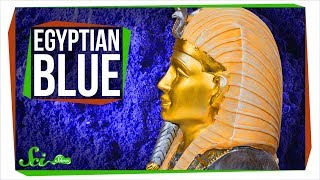The tale of the world’s first artificial pigment has all the elements of a good thriller: an ancient mystery, a dramatic rediscovery, and some cutting-edge future technology.
世界上第一种人工色素的故事中包含惊悚小说必备的所有元素:古老的秘密、戏剧性的重新发现以及一些顶尖的未来技术。
Today, this age-old chemical compound may help scientists prevent forgery and even save lives.
如今,这个古老的化合物或许能够帮助科学家们预防伪造、甚至拯救生命。
But before it was doing any of that, it was adding color to the tombs of Egyptian pharaohs.
但在此之前,它只是往埃及法老王的陵墓里添加的颜色。
The color blue was a big deal to the ancient Egyptians.
对古埃及人而言,蓝色非常重要。
It was the color of the sky and the Nile, and people came to associate it with creation and fertility.
这是天空和尼罗河的颜色,人们将这种颜色与产物和丰饶联系在一起。
But the earliest pigments were made from things like different minerals or charcoal, which means lots of browns, reds, and yellows.
但最早期的色素由不同的矿物或木炭制成,即棕色、红色和黄色。
One of the only natural sources of blue pigment was a rare, valuable mineral called lapis lazuli.
蓝色色素的唯一天然来源是一种稀有珍贵的矿物--天青石色。
It was ground up and turned into a deep blue pigment known as ultramarine.
天青石色被磨碎并变成一种深蓝色素--深蓝色。
And instead of paying big bucks for that blue, the ancient Egyptians got creative with some chemistry and invented the world’s first artificial pigment.
古埃及人并不需要用钱换取这种深蓝色,他们利用一些化学过程创造出了世界上第一种人工色素。
Egyptian blue first appeared around 2600 BCE and eventually spread throughout Mesopotamia and the Roman empire.
埃及蓝首次出现于约2600BC,最终传遍美索不达米亚和罗马帝国。
The only information we have about how it was made in ancient times comes from a Roman writer named Vitruvius.
关于古人如何制作埃及蓝的唯一信息来自于一位名叫维特鲁威的罗马作家。
The ingredients were sand, which we now know was probably made of quartz, copper-containing minerals, and natron,
制作的原材料是沙子,而如今我们了解到其可能由石英、含铜的矿物以及天然碳酸钠制成,
which is a salty mix of different sodium compounds that Egyptians used for embalming, too.
也是埃及人用于保存尸体不腐的不同钠化合物的含盐混合。
You had to mix this stuff together, shape it into balls, stick those in a clay jar, and heat them in an oven.
你需要将这些物质相混合、制成球形、将其黏在瓦罐内然后在灶中加热。
Then, you could grind them up to get some blue pigment!
然后你可以将它们碾碎并得到蓝色色素!
This pigment was used in paint for wall art or mummy coffins, or in glazes for pottery.
这种色素被用于墙画、木乃伊棺木或陶器的釉料。
But as other colors like red and yellow became all the rage in Roman art, Egyptian blue lost popularity.
但随着其他颜色,如红色和黄色在罗马艺术中风靡,埃及蓝就逐渐落寞。
By around the fourth century, it began to fall out of use. And, eventually, the formula for making it was lost.
直至约四世纪左右,埃及蓝才逐渐废弃。最终,制作埃及蓝的配方失传。
The story picks up in 1814, when archaeologists found Egyptian blue while excavating the ruins of Pompeii.
1814年这个故事才被人们发现,当考古学家们挖掘庞贝废墟时才发现了埃及蓝。

They sent samples to London for analysis, where chemists tried to figure out what it was made of by mixing it with and dissolving it in other substances and seeing what happened.
他们将样本送至伦敦检验,通过将其与其他物质混合溶解以及观察其相互反应,化学家们试图弄明白其构成物质是什么。
After a lot of experimentation, we now know that the chemical name of Egyptian blue is calcium copper tetrasilicate.
经过多次试验后,我们现在知道了埃及蓝的化学名称是四硅酸盐钙铜。
This could have been made by heating the ingredients Vitruvius mentioned — quartz sand, a copper compound, and natron — along with calcium-containing lime,
通过加热维特鲁威提到的配方--石英砂、铜化合物、天然碳酸钠以及含钙的石灰
which may have been hanging out in the sand the ancient Egyptians used.
这个或许能在埃及人使用的沙子中找到。
This mixture needs to be kept at around 900 or 1000 degrees Celsius for a couple hours to make the magic happen.
要将混合物保存在900或1000摄氏度左右的温度中几个小时,魔法才会发生。
We still don’t know how the ancient Egyptians originally figured this recipe out,
我们仍不知道古埃及人最初是如何得到这个配方的,
but the chemical reaction would have required careful control of this super hot temperature and the flow of oxygen into a furnace.
但化学反应对这种特高温以及火炉中的氧流量有着谨慎的要求。
Not only that, but the consistency of their results was also incredible — Egyptian blue pigment is almost exactly the same chemical in tombs built across nearly 3000 years.
不仅如此,他们结果的一致性也同样惊人--埃及蓝色素和3000年左右所建陵墓几乎有着相同的化学物。
And, today, the pigment is still surprising us.
而今天,色素仍在给我们惊喜。
Scientists discovered in 2009 that, when visible light is shined on them, Egyptian blue molecules emit infrared radiation — the long-wavelength light that our eyes can’t detect,
2009年科学家们发现,当可见光照耀到色素上时,埃及蓝分子会发出红外辐射--我们的眼睛无法察觉的长波长光,
but can be felt as heat or be picked up by certain cameras.
但可以感受到热度或是被某种相机捕捉到。
This makes the pigment easy to identify in ancient artwork.
这使得色素在古代艺术品中容易辨别。
Scientists can even determine if a worn-away sculpture or other piece of art was once painted blue from traces of the chemical.
科学家甚至能够从化学物的痕迹中判断某个侵蚀的雕塑或其他部件是否曾被刷上蓝色。
But this property of Egyptian blue means it has a bunch of other potential uses as well.
但是埃及蓝的这种性质意味着它还有其他的潜在用途。
Infrared can pass through human tissue more easily than some other wavelengths of light, like the visible spectrum or UV.
相比其他光的长波长,红外线更加容易的穿过人体组织,比如可见光谱或UV。
So it could be incorporated into a dye for new medical imaging techniques.
因此它可以成为医学影像技术染料的一部分。
It could also be used in new types of security ink to prevent counterfeiting and forgery.
它还可以被用于一款新的防伪油墨以防止伪造。
Or it could be made into a dusting powder for fingerprint detection on shiny or patterned surfaces, where normal fingerprint powder is hard to see.
或者可以被制成一种隔离剂用于光滑面或图形化表面的指纹检测,普通指纹粉在这些表面中很难探测。
Ancient chemists trying to paint a blue sky on the walls of tombs could never have imagined the ways their work would be used today.
当古代化学家试图在古墓壁上画蓝天时,他们或许从未想过这些色素还有今天这些用途。
But the story of Egyptian blue, it seems, is just beginning — again.
但埃及蓝的故事似乎又开始了。
Thanks for watching this episode of SciShow! For more on the science of color, check out our video where Stefan talks about 3 colors that scientists discovered!
感谢收看本期科学秀!更多关于颜色的科学,请观看Stefan谈论科学家们所发现的3种颜色的视频。
And if you want to keep getting smarter with us, you can always go to youtube.com/scishow and subscribe.
如果你想和我们一起变得更加睿智,你可以登录youtube.com/scishow,订阅我们的频道。












